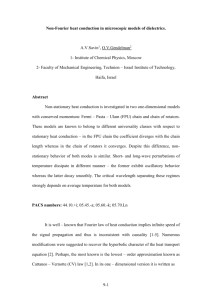Paper
advertisement
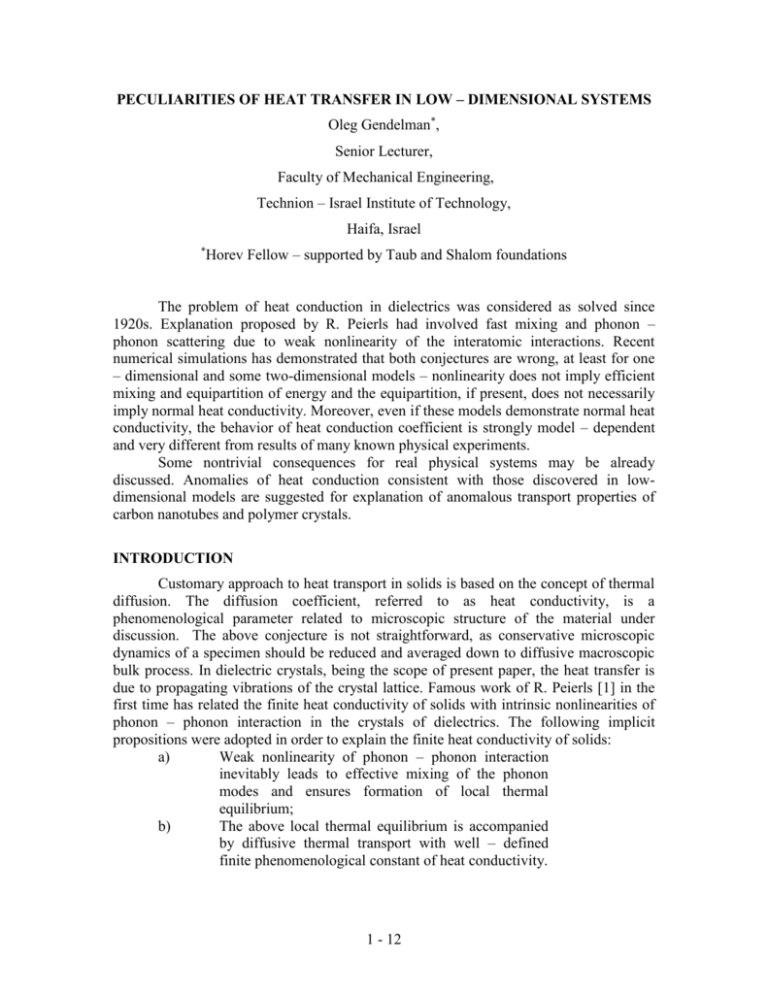
PECULIARITIES OF HEAT TRANSFER IN LOW – DIMENSIONAL SYSTEMS Oleg Gendelman*, Senior Lecturer, Faculty of Mechanical Engineering, Technion – Israel Institute of Technology, Haifa, Israel Horev Fellow – supported by Taub and Shalom foundations * The problem of heat conduction in dielectrics was considered as solved since 1920s. Explanation proposed by R. Peierls had involved fast mixing and phonon – phonon scattering due to weak nonlinearity of the interatomic interactions. Recent numerical simulations has demonstrated that both conjectures are wrong, at least for one – dimensional and some two-dimensional models – nonlinearity does not imply efficient mixing and equipartition of energy and the equipartition, if present, does not necessarily imply normal heat conductivity. Moreover, even if these models demonstrate normal heat conductivity, the behavior of heat conduction coefficient is strongly model – dependent and very different from results of many known physical experiments. Some nontrivial consequences for real physical systems may be already discussed. Anomalies of heat conduction consistent with those discovered in lowdimensional models are suggested for explanation of anomalous transport properties of carbon nanotubes and polymer crystals. INTRODUCTION Customary approach to heat transport in solids is based on the concept of thermal diffusion. The diffusion coefficient, referred to as heat conductivity, is a phenomenological parameter related to microscopic structure of the material under discussion. The above conjecture is not straightforward, as conservative microscopic dynamics of a specimen should be reduced and averaged down to diffusive macroscopic bulk process. In dielectric crystals, being the scope of present paper, the heat transfer is due to propagating vibrations of the crystal lattice. Famous work of R. Peierls [1] in the first time has related the finite heat conductivity of solids with intrinsic nonlinearities of phonon – phonon interaction in the crystals of dielectrics. The following implicit propositions were adopted in order to explain the finite heat conductivity of solids: a) Weak nonlinearity of phonon – phonon interaction inevitably leads to effective mixing of the phonon modes and ensures formation of local thermal equilibrium; b) The above local thermal equilibrium is accompanied by diffusive thermal transport with well – defined finite phenomenological constant of heat conductivity. 1 - 12 These two long – believed statements became open for verification with the help of simplified low – dimensional models as a result of development of numerical simulation techniques. To day t is clear that, generally speaking, both of them are wrong. The problem started from the work of Fermi, Pasta, and Ulam (FPU) [2], where the absence of fast mixing in a chain with weakly nonlinear potential of nearest – neighbor interaction was detected for the first time. It was afterwards understood that non-integrability of the system is a necessary condition for normal heat conductivity. As it was demonstrated recently for the FPU lattice [3, 4], disordered harmonic chain [5, 6, 7], diatomic 1D gas of colliding particles [8, 9, 10, 11], and the diatomic Toda lattice [12], the non-integrability is not sufficient in order to get normal heat conductivity. It leads to a linear distribution of temperature along the chain for small gradient, but the value of heat flux is proportional to 1/Nk, where N is the number of particles in the chain and number exponent 0 < k < 1. Thus, the coefficient of heat conductivity diverges in the thermodynamic limit N→∞. Analytical estimations [4] have demonstrated that any chain possessing an acoustic phonon branch should have infinite heat conductivity in the limit of low temperatures. From the other side, there are some artificial systems with on-site potential (dinga-ling and related models) having normal heat conductivity [13, 14]. The heat conductivity of the Frenkel-Kontorova chain was first considered in Ref. [15]. Finite heat conductivity for certain parameters was obtained for Frenkel-Kontorova chain [16], for the chain with sinh-Gordon on-site potential [17], and for the chain with φ4 on-site potential [18, 19]. These models are not invariant with respect to translation and the momentum is not conserved. It was supposed that the on-site potential is extremely significant for normal heat conduction [18] and that the anharmonicity of the on-site potential is sufficient to ensure the validity of Fourier’s law [20]. A recent detailed review of the problem is presented in Ref. [21]. Probably the most interesting question related to the heat conductivity of 1Dmodels (which actually stimulated the first investigation of Fermi, Pasta and Ulam [1]) is whether small perturbation of the integrable model will lead to convergent heat conduction coefficient. It is supposed that for the one-dimensional chains with conserved momentum the answer will be negative [22]. Still, normal heat conduction is observed in some special systems with conserved momentum [23, 24, 25], but it may be clearly demonstrated only well apart from the integrable limit. It means that mere nonintegrability is insufficient to ensure normal heat conduction if additional integral is present. In the systems with on-site potential the situation is not so clear. Although it was supposed that non-integrable system without additional integrals of motion would have convergent heat conductivity [22], no rigorous proof was presented. From the other side, recent attempt of numerical simulation of the heat transfer in Frenkel-Kontorova model [26] demonstrated that because of computational difficulties no unambiguous conclusion can be drawn whether the heat conduction remains convergent for all finite values of perturbation of the integrable limit system (linear chain or continuous sine-Gordon system). It seems that the computational difficulties of investigation of the heat conduction in the vicinity of the integrable limit are not just issue of weak computers or ineffeective procedures. In the systems with conserved momentum the divergent heat conduction is 1 - 13 fixed by power-like decrease of the heat flux autocorrelation function with power less than unity. Still, for the systems with on-site potential exponential decrease is more typical [26]. For any fixed value of the exponent the heat conduction converges; if the exponent tends to zero with the value of the perturbation of the integrable case, then for any finite value of the perturbation the characteristic correlation time and length will be finite but may become very large. Consequently, they will exceed any available computation time or size of the system and still no conclusion on the convergence of the heat conduction will be possible. In this respect it is reasonable to mention the findings of papers [24, 25, 26] concerning the transitions from infinite to finite heat conduction in the chain of rotators and Frenkel - Kontorova system. These findings were criticized in paper [27] by providing the computation results for larger systems. We agree with the authors that the results of papers [24, 25, 26] do not prove the reality of the above transition; actually, in paper [26] it is stated explicitly. From the other side, it is clear that such more extended numerical simulations cannot prove that the transitions do not exist at all. Probably, such conclusion may be driven if, with the help of some not yet developed method, the simulation length or effective time will be extended by many orders of magnitude. Present paper is aimed to illustrate the above – mentioned developments and the state – of – art in the field of heat conduction in low – dimensional systems. Few groups of models will be considered and major findings will be outlined. Relation of the results for low – dimensional systems to the heat conductivity of real 3D objects as well as possible applications will be also discussed. CONSERVED - MOMENTUM 1D MODELS The first group of models (including FPU model mentioned above) investigated from the viewpoint of the heat conductivity was the group of models with conserved momentum. More exactly, the investigators have considered various models with the Hamiltonian p2 1 i V ( xi xi 1 ) (1) 2 i mi i where pi are momenta of the particles, mi – their masses, xi – their displacements and v – potential of nearest - neighbor interactions. Such model obviously conserves the total momentum of the system P= pi . i For this group of models two distinctly different scenarios of the heat conduction were revealed. The first one [21] is related to majority of the models investigated and is characterized by linear temperature distribution along the chain subject to thermal gradient; local thermal equilibrium also can be achieved. Still, the heat conduction coefficient diverges in the thermodynamical limit of very large system. Two examples of this sort are presented at Fig. 1-2 (see [21] for more information). 1 - 14 Fig. 1 Thermal conductivity of the FPU model with quartic nonlinearity versus lattice length N for T+ =011; T_ =0,09. The inset shows the effective growth rate of the scaling exponent of the heat conduction versus N. Circles and diamonds correspond to free and fixed boundary conditions respectively. Fig. 2 Thermal conductivity of the FPU model with quartic nonlinearity, T+= 150; T- = 15, fixed boundary condition. The result presented above (thermalization with divergent heat conduction coefficient) is typical for big variety of models. Actually, only one interesting exception is known, and it is a system with periodic nearest neighbor potential. The simplest form of this potential is expressed as V ( x) 1 cos x (2) Chain with potential (2) was the first one – dimensional lattice with conserved momentum which demonstrated convergent heat conductivity. Fig. 3 illustrates this finding. 1 - 15 Fig. 3 . Dependences of the natural logarithm of the thermal conductivity coefficient on the natural logarithm of the chain fragmennt with length N1. Circles 1 correspond to the numerically calculated values at temperature T = 0.2 (T+ = 0.21 and T-= 0.19). Straight line 2 approximating this dependence has the slope d = 0.26. Squares 3 indicate the numerically calculated values at temperature T = 0.3 (T+ = 0.33 and T- = 0.27). Straight line 4 approximating this dependence has zero slope (k = 31.8). The reason for unusual behavior of the heat conduction coefficient is that potential (2) allows formation of high – frequency discrete rotational modes (rotobreathers) which prevent free propagation of the heat flux. Their effect on the heat transport is illustrated at Fig. 4. Fig.4 Energy relaxation of the thermalized chain at temperature T = 3. Dependences of the local energy En on the number n of the chain unit and on the time t. At the initial instant, the system has the temperature T; then, the dynamics of the chain with the absorbing ends is considered (N = 300, and T+= T-= 0). 1 - 16 Thus, it is possible to conclude that in general one – dimensional chain with conserved momentum cannot reproduce the properties of real 3D systems with diffusive heat transport, unless some very special cases are considered. This circumstance eventually led to consideration of more complicated models with on-site potential. 1D MODELS WITHOUT MOMENT CONSERVATION Typical Hamiltonian for this sort of models is as follows: pi2 1 V ( xi xi 1 ) U ( xi ) (3) 2 i mi i Models with Hamiltonian (3) do not conserve global momentum and generally have no integrals of motion besides total energy. These discrete models with intrinsic nonlinearity were believed to have convergent heat conduction. Still, it turned out to be not easy to demonstrate that by means of numerical simulation. Exampel of these difficulties is presented at Fig. 5 for a model with harmonic V(x) and sinusoidal U(x) (Frenkel – Kontorova model). Fig.5.Dependence of the heat conductivity coefficient on the reduced temperature for the chain with periodic on-site potential and different discreteness ratio. It is unclear whether the heat conduction diverges or remains finite but b=very large. In order to elucidate this problem other model has been proposed, based on impact nonlinearity. Let us consider the one-dimensional system of hard particles with equal masses subject to periodic on-site potential. Interaction of absolutely hard particles is described by the following potential V (r) = ∞ if r < d and V (r) = 0 if r > d, where d is the diameter of the particle. This potential corresponds to pure elastic impact with unit recovery coefficient. 1 - 17 It is well-known that the elastic collision of two equal particles with collinear velocity vectors leads to exchange of their velocities. The one-dimensional chain of equivalent hard particles without external potential is a paradigm of the integrable nonlinear chain, since all interactions are reduced to exchange of velocities. Presence of external potential does not change this fact, since the collision takes zero time and thus the effect of the external force on the energy and momentum conservation is absent. If the diameter of the particles is zero, then the energies of the quasiparticles associated with “moving pulses” are preserved in the collision. Therefore effectively the interaction between the quasiparticles disappears and the chain of equal particles with zero size subject to any on-site potential turns out to be completely integrable system. Thus contrary to many previous statements it is possible to construct an example of strongly nonlinear one-dimensional chain without momentum conservation, which will have clearly divergent heat conductivity (even linear temperature profile will not be formed). The situation differs if the size of the particles is not zero, as the energies of the particles are not preserved in the collisions. In order to consider the effect of such interaction we proposed simplified semi-phenomenological analytical model [28] based on standard singular perturbation technique. Main result is presented at Fig.6. Fig.6 Dependence of the coefficient of the exponential decrease of the autocorrelation function (a) and the coefficient of the heat conduction ·(b) on the particle diameter d of 1D gas at T=1. Curves 1 and 2 correspond to piecewise linear on-site potential, curve 3 represents theoretical predictions. 1 - 18 The above results mean that there exists a new class of universality of 1D chain models with respect of their heat conductivity. The limit case of zero-size particles is integrable, but the slightest excitation of this integrable case by introducing the nonzero size leads to drastic change of the behavior – it becomes diffusive and the heat conduction coefficient converges. It should be stressed that this class of universality, unlikely the systems with conserved momentum, cannot be revealed by sole numerical simulation. The reason is that the correlation length (as well as the heat conduction coefficient) diverges as the system approaches the integrable limit; therefore any finite capacity of the numerical installation will be exceeded. That is why the analytical approach is also necessary. MODELS IN HIGHER DIMENSIONS Much less is known on the behavior of simple dynamical models in two and three dimensions. Generally adopted point of view is that for two – dimensional case the heat conduction of momentum – conserving model is logarithmically divergent. This result is illustrated at Fig. 7 for the case of two –dimensional symmetric FPU lattice and lattice with Lennard – Jones interactions. Fig. 7 Heat conductivity versus the system size Nx for the 2d FPU (a) and Lennard–Jones (b) models. In panel (a) T+ =20 and T- =10; in panel (b) T+ =1 and T=0:5. In both cases, statistical errors have the size of the symbols. Still, the above results were obtained for square lattice with pertinent dynamical instability. More refined investigations are required in order to establish the heat conduction peculiarities in two dimensions. The situation in three dimensions may be characterized as almost complete ignorance, besides some preliminary indications of finite heat conduction in extremely simplified model [29]. DISCUSSION: POSSIBLE APPLICATIONS In spite of very preliminary and incomplete understanding of the heat conduction in low – dimensional models it is already possible to figure out few real physical objects which are supposed to exhibit anomalies related to low effective dimensionality. The first example of this sort is a polymer crystal [30]. Thermal conductivity is dependent on the length of polymer chain, as presented at Fig. 8. 1 - 19 Fig. 8 Thermal conductivity as a function of pressure, T=273 K. (1) C9H20 (2)C11H24 (3) C13H28 (4) C15H32 (5)C17H36 (6)C19H40 The discrepancies in heat conduction for various chain length are attributed to one – dimensional aspects of the chain dynamics. The other very interesting example with suggested two – dimensional dynamics is carbon nanotubes. These objects are schematically presented at Fig.9 Fig. 9 a) C60 b) C70 c) C80 d) C260 Heat conduction in these systems is now a subject of numerous extensive studies. To mention just the most recent result, in paper [31] it was demonstrated that the heat conduction coefficient in single – walled nanotubes diverges as approximately L0.3 where l is a length of the tube. 1 - 20 Thus, it is possible to conclude that the low – dimensional anomalies which were previously related only to curious problem of grounding Fourier law are completely pertinent for describing peculiarities of heat transport in real physical systems. REFERENCES 1. R. Peierls, 2. E. Fermi, J. Pasta, and S. Ulam, Los Alamos Rpt LA-1940, 1955. 3. S. Lepri, L. Roberto, and A. Politi, Phys. Rev. Lett. 78, 1896 (1997). 4. S. Lepri, R. Livi, and A. Politi, Evrophys. Lett. 43, 271 (1998). 5. R. Rubin andW. Greer, J.Math. Phys. (N.Y.) 12, 1686 (1971). 6. A. Casher and J.L. Lebowitz, J.Math. Phys. (N.Y.) 12, 1701 (1971). 7. A. Dhar, Phys. Rev. Lett. 86, 5882 (2001). 8. A. Dhar, Phys. Rev. Lett. 86, 3554 (2001). 9. A.V. Savin, G.P. Tsironis, and A.V. Zolotaryuk, Phys. Rev. Lett. 88, (15)/154301 (2002). 10. P. Grassberger,W. Nadler, and L. Yang, Phys. Rev. Lett. 89, 180601 (2002). 11. G. Casati and T. Prosen, Phys. Rev. E, 67, 015203, 2003. 12. T. Hatano, Phys. Rev. E 59, R1 (1999). 13. G. Casati, J. Ford, F. Vivaldi, and V.M. Visscher, Phys. Rev. Lett. 52, 1861 (1984). 14. T. Prosen,M. Robnik, J. Phys. A 25, 3449 (1992). 15. M. J. Gillan, R.W. Holloway, J. Phys. C 18, 5705 (1985). 16. B. Hu, B. Li, and H. Zhao, Phys. Rev. E 57, 2992 (1998). 17. G.P. Tsironis, A.R. Bishop, A.V. Savin, and A.V. Zolotaryuk, Phys. Rev. E 60, 6610 (1999). 18. B. Hu, B. Li, and H. Zhao, Phys. Rev. E 61, 3828 (2000). 19. K. Aoki and D. Kuznezov, Phys. Lett. A 265, 250 (2000); arXiv:chao-dyn/9910015. 20 F. Bonetto, J.L. Lebowitz and L. Ray-Bellet in Mathematical Physics 2000, ed. A. Fokas, A.Grigoryan, T. Kibble and B. Zegarlins 21. S. Lepri, R. Livi, and A. Politi, Physics Reports 377, 1-80 (2003). 22. O. Narayan and S. Ramaswamy, Phys. Rev. Lett. 89 200602 (2002). 23. C. Giardina, R. Livi, A. Politi, andM. Vassalli, Phys. Rev. Lett. 84 2144 (2000). 24. O.V. Gendelman and A.V. Savin, Phys. Rev. Lett. 84, 2381 (2000). 25. A.V. Savin and O.V. Gendelman, Fizika Tverdogo Tela 43, 341 (2001) [Physics of the Solid State 43, 355 (2001)]. Phys. Rev. Lett. 87, 069401 (2001). 26. A.V. Savin and O.V. Gendelman, Phys. Rev. E, 67 041025 (2003). 27. L. Yang and P. Grassberger, arXiv:cond-mat/0306173 v1 6 Jun 2003. 28. O.V.Gendelman and A.V.Savin, Phys. Rev. Letters, v.92, n.7, 074301 1-4 29. T. Shimada, T. Murakami, S. Yukawa, K. Saito, N. Ito, J. Phys. Soc. Japan 10 (2000) 3150. 30. H. Forsman, P. Anderson, J. Chem. Phys. 80 (1984) 2804 31. Gang Zhang and Baowen Li, arXiv:cond-mat/0403393 v1 16 Mar 2004 1 - 21
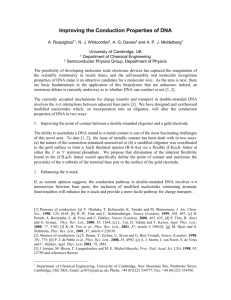
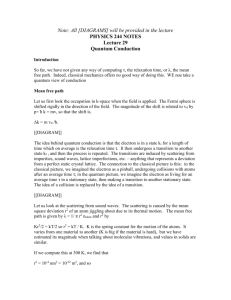

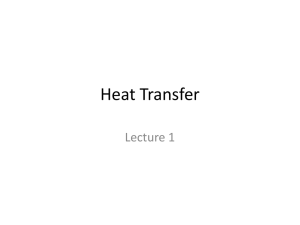
![[1]. In a second set of experiments we made use of an](http://s3.studylib.net/store/data/006848904_1-d28947f67e826ba748445eb0aaff5818-300x300.png)
